Fitness App Development Services
Dive into the future of fitness and wellness with our unparalleled expertise and technological prowess. From conceptualization to execution, we, as a fitness apps development company, specialize in crafting top-tier fitness solutions - tailored for fitness industry leaders.
Custom Fitness & Workout Solutions
Activity Health Tracking & Integrating with Health APIs
BLE, Serial & Wearable Integration
Fitness Application Development – Market Overview
The market for fitness application development services can be segmented into various categories:
workout and exercise fitness apps;
diet and nutrition apps;
prevention and health wellness apps.
Each of these segments has experienced growth, with workout and exercise apps being the most popular businesses among users. The global fitness app market growth expectations from 2023 to 2028 by Statista:
14.96%
A compound annual growth rate (CAGR)
$10.04B
Market size
+2.23%
User penetration (from 10.85% to 13.08%)
$13.92
Average revenue per user (ARPU)
$1.506B
United States projected revenue
As people become more health-conscious, our fitness mobile app development company focuses on attracting and retaining a larger user base by offering innovative fitness apps and digital solutions.
Fitness App Development Services Our Company Offers
Companion Apps for Fitness Equipment & Wearables
As part of our fitness app development services we build mobile solutions for BLE- and ANT+-enabled fitness equipment and wearables – with stable connectivity, seamless data sync, and smooth device management. This includes kiosk-based Android console apps, like the one we built for STEPR.
BLE and ANT+ pairing, reconnection, and device control
Integration with HealthKit, Google Fit & Fitbit
Companion apps and kiosk UIs for connected fitness products
On-Demand Fitness & Streaming Platforms
We provide end-to-end development services for scalable platforms for workout streaming, progressive training plans, and AI-powered recommendations – with fitness app development solutions like built-in gamification, goal setting, community features, and flexible subscription models.
Video libraries, workout plans & streaming (e.g. Vimeo)
Gamification: streaks, leaderboards & rewards
AI-powered suggestions & personalized training flows
UX Optimization & UI Relaunch
Through our AI fitness app development services we help fitness brands relaunch or optimize their apps based on real usage data – with improved user flows, enhanced user engagement, modern interface design, and conversion-focused UX enhancements.
Heatmaps & user behavior tracking (e.g. Clarity)
A/B testing & UX fixes for existing apps
Design systems tailored to fitness-specific use cases
Backend, CMS & Admin Dashboards
We develop scalable backend solutions and flexible admin tools for content management, user control, and real-time device communication – including NFC-based interactions – hosted on AWS, Firebase, or DigitalOcean.
API-first architecture with headless CMS (e.g. KeystoneJS)
Admin panels with user and device management
Cloud hosting on AWS, Firebase or DigitalOcean
Data-Driven Product Insights
A key part of Stormotion’s fitness app development services, is to implement product analytics to help teams make informed decisions – from feature usage to conversion funnels and roadmap prioritization.
Analytics integration & heatmap tools (e.g. Clarity)
User segmentation & feature usage tracking
Insight-based product & UX improvements
Lifestyle & Wellbeing Apps with Engagement Features
We create digital products through tailored development services that promote healthy routines – combining habit or fitness tracking with rewards, missions, and social features to keep users engaged.
Habit tracking & daily missions
Points, badges & reward logic
Social sharing & in-app community features
Why Choose our Fitness App Development Company?
Extensive Experience in Health and Fitness App Development
While helping fitness companies to build cost-effective and remarkable Web & App Fitness Solutions - we have encountered various cases and gathered (in)valuable experience. We don’t just build apps - we build successful fitness platforms that engage and retain users.
Technology Consulting
Our Lead Health and Fitness App Developers will select and deploy the best technology stack, whether for iOS or Android, to ensure your fitness application continue to grow, remain adaptable to market changes, and leverage the latest technological advancements.
Platform-Agnostic Development
We ensure the availability of fitness applications across multiple platforms with cross-platform capabilities that work on desktop, mobile, and other platforms. Our technology stack supports the latest frameworks, allowing for faster deployment times and lower development costs.
Design, Development & Upkeep in one Place
Whatever is needed to ensure an engaging user experience & higher KPIs aligned with your business goals – from design development to deployment – we got your back. As a fitness app design company, we ensure that your fitness application is well-packaged and easy to navigate, which will keep users coming back.
AI-Powered Fitness App Development Services: Zone Of Expertise
- Guided Fitness Trainings
- Workout & Streaming
- Activity Tracking & Challenges
- Diet & Nutrition
- IoT & Wearables

mobile by @paradigmdesign
Guided Fitness Trainings & Coaching
In the evolving world of fitness and wellness, the top fitness app development companies have built numerous guided gym and fitness applications, leveraging BLE & Wearables. Our mobile fitness app developers practice continuous integration, seamlessly delivering new features, maintenance updates, and enhanced app security to already deployed trainer applications (including those tailored for personal trainers).
Personalized Account
Offline Support
GDPR Compliance
3rd-Party API Integration features like a Fitness Tracker
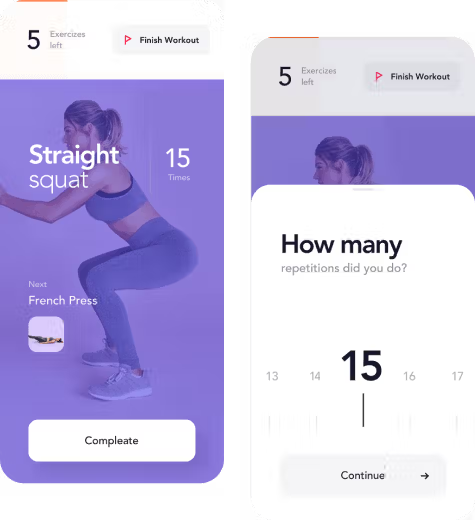
mobile by @paradigmdesign
Workout & Streaming
With more consumers craving online fitness experiences/athletic workouts accessible from the comfort of their homes, Stormotion, as a gym application development company, understands the importance of building on-demand workout live streaming apps like Peloton.
Video-on-Demand Streaming
In-App Purchases
Apple Health, Google Fit & other Fitness and Wellness APIs
Tracking Heart Rate, Cadence & other health data
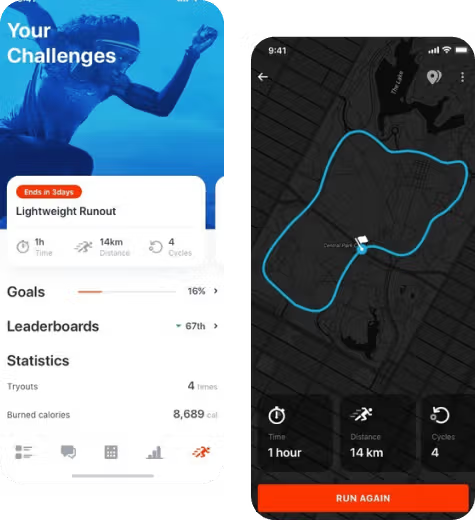
mobile by @paradigmdesign
Activity Tracking & Challenges
If you’re looking to create and deliver a fitness or healthcare app, that tracks fitness activities like steps, km run, calories, or water drunk per day - there’s no better time to start.
Steps & Distance Tracking, Calorie Counting
GPS & Location-Based Support
Apple Health, Google Fit, Garmin, Fitbit & other Health & Fitness Tracker APIs
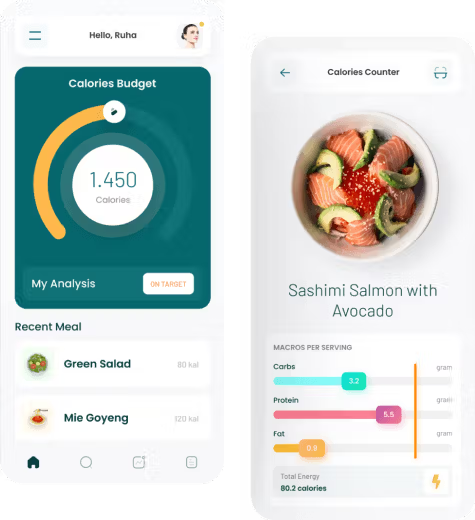
mobile by @paradigmdesign
Diet & Nutrition
Whether you’re a gym owner planning to target clients who just want to lose/gain weight, track calorie intake/nutrients, follow meal plans designed for specific food intolerances, or improve mental health through nutrition, we, as a health and fitness app development company, got your back.
Machine Learning & NLP for Recipe Recognition and Analysis
Personalized Suggestions Based on Intolerances
Integration with Recipe Schema
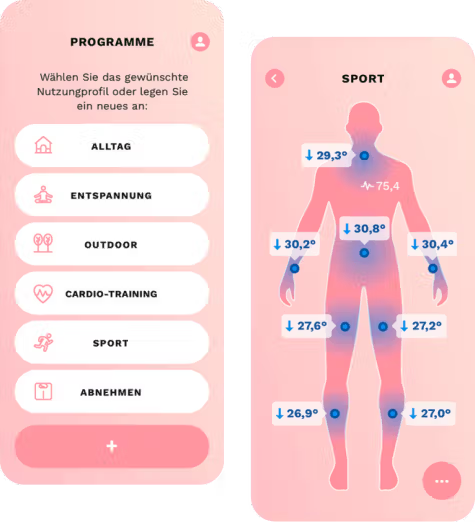
mobile by @paradigmdesign
IoT & Wearables
Are you planning to develop a fitness app utilizing algorithms aimed at keeping track of metrics such as heart rate, cadence, sleep tracking, and other data through BLE-based sensors or wearables? Cool, we’d be happy to be your fitness app development partner.
BLE & ANT+
Apple Health, Google Fit, Garmin, Fitbit & other Health and Wellness APIs
GPS & GeoLocation
Artificial Intelligence Technology
Our Bulletproof Fitness Software Development Process
Our Fitness App Development Projects
Cutting Edge Technologies for Fitness App Development
- iOS
- Android
- React
APIs:
Google Fit, Apple HealthKit, Garmin, Fitbit, Strava, Runtastic, Suunto, Withings
3rd-Party Services:
Vimeo, Firebase, AWS, GraphCMS, React Admin
Hardware:
Gyroscope, accelerometer, GPS, heart rate monitor, cadence sensor, skin galvanic reaction sensors
Languages and frameworks:
React Native; TypeScript; Swift, Java, Kotlin; React.JS; Node.JS
Our Blog
All blog posts![React Native vs Native Development [2026]: Insights from Stormotion’s CTO](https://cdn.sanity.io/images/ordgikwe/production/d3b235f9e44ba58223b1fd220eabefffe331be3a-1504x1128.png?w=1504&h=1128&auto=format)
November 26, 2025
17 min read
React Native vs Native Development [2026]: Insights from Stormotion’s CTO
![BLE System Integration for Fitness Devices: How to Connect Them to Your App]()
November 26, 2025
15 min read
BLE System Integration for Fitness Devices: How to Connect Them to Your App
![App for Fitness Device in React Native: How to Develop Guide from Technical Lead]()
November 26, 2025
29 min read
App for Fitness Device in React Native: How to Develop Guide from Technical Lead
![Case Study: How We Solve Technical Challenges for Our IoT, Mobility, and Fitness Clients]()
December 8, 2023
14 min read
Case Study: How We Solve Technical Challenges for Our IoT, Mobility, and Fitness Clients
FAQ
How much does it cost to develop a fitness app?
The costs of fitness mobile app development services depend on the type of app you want to build, needed features and technologies, and the hourly rate of your development team.
In our extensive Fitness App Development Guide, you can discover the approximate budget required for creating various types of fitness activity tracking apps. For example, the cost to build a fitness app ranges from $25,150 to $75,250, depending on the project requirements. You can find even more estimates of fitness application development in the article.
How can I monetize my fitness app?
We’ve helped teams implement proven models like subscriptions, in-app purchases for premium workouts, branded equipment companions, ads, and affiliate integrations. You can also boost retention with gamification, loyalty features, and tailored content that increases LTV (as seen with Force USA{target=_blank}).
How do I choose the right fitness app development company?
What is your process for ensuring a successful fitness app launch?
We start with discovery and user research, then create product concepts and wireframes. After that, we select the best stack (usually React Native), build cross-platform apps, run QA, and support your release with ongoing maintenance.
What Health APIs do you have experience integrating with?
Since we already have several fitness projects in our portfolio, we also have hands-on experience in integrating 3rd-Party Health & Fitness APIs. In our fitness app development agency, we particularly worked with the following APIs: Apple Health, Google Fit, Fitbit, Garmin, Runtastic, Strava, Suunto, Withings.
How do you test and debug fitness apps?
Our QA team uses both simulators and real devices, testing across iOS/Android, wearables, and BLE hardware. We apply automated and manual testing, debug edge cases like reconnection logic, and ensure smooth UX under real workout conditions.
What tech stack do you use for fitness app development?
React Native + TypeScript is our go-to for mobile. We also use Swift/Kotlin, Node.js, and React for backend/web. Integrations include HealthKit, Google Fit, Garmin, Fitbit, Strava, Vimeo, AWS, Firebase, and custom BLE protocols.
Do you provide ongoing support & post-development app maintenance?
Yes, absolutely, these are some of the fitness app development services we provide. Hire us, and we’d be happy to support you with bug fixes, SDK & API updates, OS Updates as well as further implementation of new functionality.
How do I know that my health and fitness idea and related business operations are safe with your fitness app development company?
As your reliable fitness app developers, we value the best security of your data, including adherence to HIPAA regulations where applicable. Thus, we normally sign and follow an NDA with all of our partners. It ensures that all the sensible information stays within our fitness app development firm, whether it’s your health fitness app idea and business model, wireframes, or a live app demo.
What are the latest trends in fitness app development?
We see rapid adoption of AI-driven recommendations, gamification & challenges, embedded Android console apps, wearable & BLE connectivity, and data-driven UX improvements that turn apps into sticky ecosystems.
What features can be included in my fitness app?
Any features that are necessary to meet your fitness business goals. Since we provide custom health and fitness mobile app development services, we tailor the development to your use case. Thus, it can be any of the features mentioned in the section above or any other advanced features for your Fitness Product.
Can you also develop a Web-Version of my App?
Yes, we have experience in porting the Fitness Product to Web. You can find a relevant case study in the portfolio of our fitness app development company – first, we built the FitTracks mobile app, and then we converted it into the FitTracks Web App.
Do you work with legacy projects?
Yes, we can help with maintenance or further development of your existing application. We can also redesign your application or convert it from iOS to Android (or vice versa).
Can you develop a clone of an existing fitness app?
Yes, we can develop a clone of an existing fitness app. However, it’s important to understand a few key aspects of this process:
- Legal Aspects: Direct copying may infringe on copyright, so we recommend adding unique elements.
- Functionality: We can implement in-demand features and offer innovative solutions.
- Cost: The development of a clone depends on the complexity of the app and the number of features. For example, the cost to create an app like Fitbit ranges from $98,300 to $143,850, while the cost of making the Peloton app ranges from $92,050 to $145,000.
Contact us to discuss your ideas or to consult regarding the exact cost of such an app! We hope to help you develop a unique solution that stands out from the crowd, matches your company's identity, and meets your business needs.
Do you offer built-in analytics to monitor workouts and goals?
We include built-in analytics that make it easy to check key user information, such as how often a customer works out, their goal achievement, session duration, and user engagement level.
How long does it take to build a fitness app?
The timing depends on the app's objectives and the features it provides. Taking all features into account, the development and design of most fitness apps can take anywhere from 3 to 6 months or even longer. We can provide a detailed project cost estimate after getting to know you and your idea.
Do you sign a Non-Disclosure Agreement (NDA)?
Absolutely. We sign an NDA with each of our clients before going into the details of your project. Your ideas and business information are always safe when you use our company's services.
Can you develop fitness apps for iOS and Android platforms?
We specialize in creating apps in React Native, a cross-platform framework that works seamlessly on both iOS and Android. This approach to app development speeds up the fitness app development process and helps save money without compromising on quality and functionality.
What measures do you take to secure user data in the app?
We use industry-leading security methods, including end-to-end encryption, blockchain, secure authentication methods, and GDPR-compliant data processing. As part of our post-release support, we also regularly review safety updates and ensure the ongoing security of your users' data.


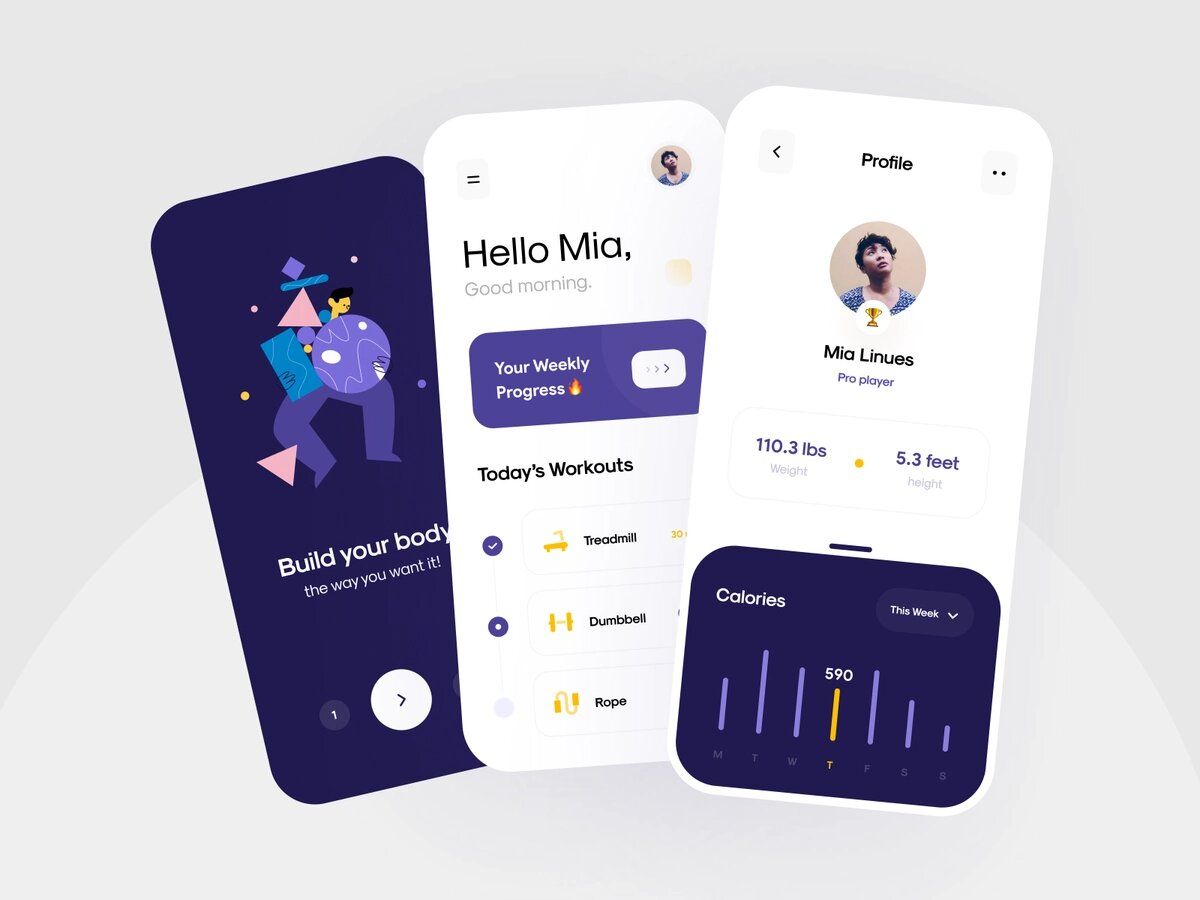


Testimonials
SHUFFLE THROUGH THE SLIDER. DRAG OR SWIPE